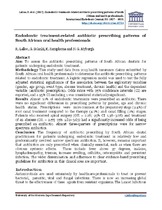| dc.description.abstract | AIMTo assess the antibiotic prescribing patterns of South African dentists for patients undergoing endodontic treatment.
METHODOLOGY This study used data from 2013 health insurance claims submitted by South African oral health professionals to determine the antibiotic prescribing patterns related to endodontic treatment. A logistic regression model was used to test the fully adjusted statistical significance of the association between the exploratory variables (gender, age group, event type, abscess treatment, chronic health) and the dependent variable (antibiotic prescription). Odds ratios with 95% confidence intervals (CI) are reported, and a 95% CI excluding 1 was considered statistically significant.
RESULTS Almost 10% of endodontic treatments were prescribed an antibiotic. There were no significant differences in prescribing patterns by gender, age and chronic health status. Prescriptions were more common at the preparatory stage (9.4%) of root canal treatment compared to the therapy (4.7%) and canal filling (2%) stages. Patients who received apical surgery (OR = 2.28; 95% CI 1.38–3.76) and treatment of an abscess (OR = 2.57; 95% 1.82–3.63) had a significantly increased odds of being prescribed an antibiotic. Almost three-quarters of prescriptions were for narrow spectrum antibiotics.
CONCLUSION The frequency of antibiotic prescribing by South African dental practitioners for patients undergoing endodontic treatment is relatively low and predominantly involved narrow spectrum antibiotics. It, however, remains important that antibiotics are only prescribed when clinically essential, such as when there are obvious systemic effects. These include fever above 37 degrees, malaise, lymphadenopathy, trismus, increase swelling, cellulitis, osteomyelitis and persistent infection. The wider dissemination and adherence to clear evidence-based prescribing guidelines for antibiotics in this clinical area are important. | en_US |

